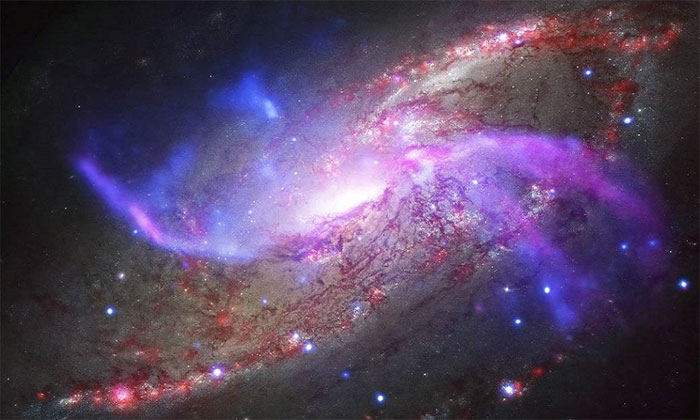Detecting bright galaxies like fireworks in the universe
The US Aerospace Agency (NASA) on December 31, 2019 shared photos that reveal the structure and glow of the spiral galaxy NGC 4258.
Galaxy NGC 4258 located about 23 million light-years from Earth revolves like a blooming fireworks with a giant black hole in the center, shockwaves and surrounding gas reserves.

Spiral galaxy NGC 4258. (Image: NASA).
Galaxy NGC 4258 is famous for its glowing spiral arms called anomalous arms . They are not aligned with the galactic plane plane of the intersection. In the new composite image, NASA researchers use blue, purple, yellow, and red to represent X-ray data of Chandra X-ray observatory, radio data of Karl Jansky Observatory. Very Large Array, optical data of the Hubble space telescope and infrared data of the Spitzer space telescope.
New research using Spitzer glass shows that galactic shock waves are heating massive amounts of gas, the equivalent of 10 million solar masses. The team believes that the supermassive black hole at the center of NGC 4258 is producing extremely high energy streams. These stream of particles hit the disk surface of the galaxy, creating shockwaves. The shockwave again heated the gas, mainly composed of billions of hydrogen, to thousands of degrees Celsius.
Chandra data reveals huge hot gas bubbles above and below the plane disk. The air bubble reflects the amount of gas in the flat disc that is heated and shoots out the surrounding area. The researchers estimate that all the remaining gas will erupt in the next 300 million years unless added. Because most of the gas has been consumed, NGC 4258 has very little gas to form new stars. They estimate that stars form in the central region of NGC 4258 at a rate 10 times slower than the Milky Way.
- Detecting spiral galaxies in the early universe
- A photo of a spiral galaxy 65 million light years away
- Revealing the first fireworks photo in the universe
- Detecting a group of 'ghost galaxies'
- How many galaxies in the universe?
- Detecting the galaxy seems to not exist
- The birth history of fireworks
- Detecting a bright group of galaxies more than 3 trillion times the Sun
- Let's see the structure of each firework
- Clash between two galaxies
- Set of three galaxies in the dawn of the universe
- Decoding adds a mystery of the universe
- The incalculable harm of fireworks
- 5 most impressive galaxies in the universe
 Van Allen's belt and evidence that the Apollo 11 mission to the Moon was myth
Van Allen's belt and evidence that the Apollo 11 mission to the Moon was myth The levels of civilization in the universe (Kardashev scale)
The levels of civilization in the universe (Kardashev scale) Today Mars, the sun and the Earth are aligned
Today Mars, the sun and the Earth are aligned The Amazon owner announced a secret plan to build a space base for thousands of people
The Amazon owner announced a secret plan to build a space base for thousands of people